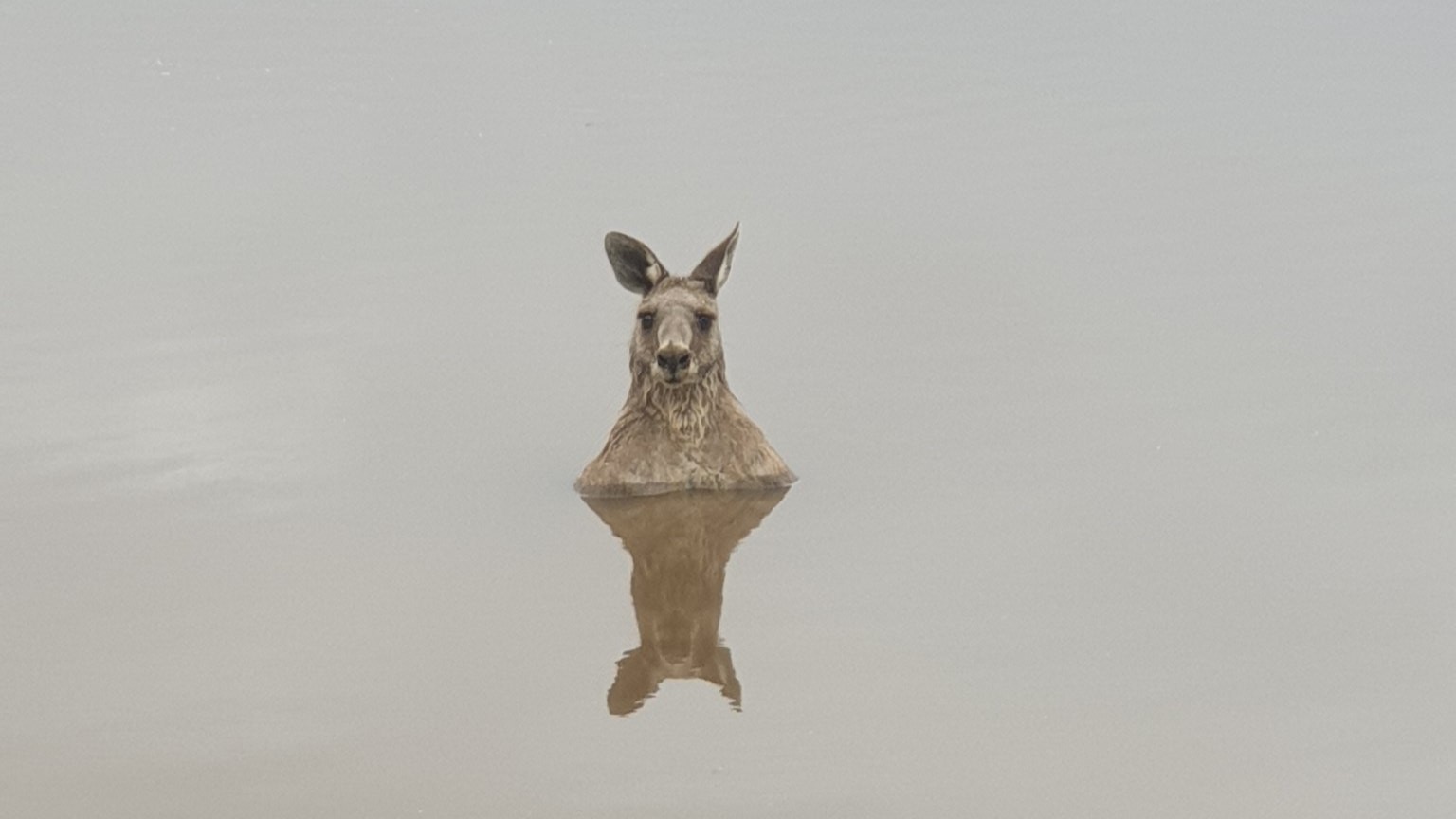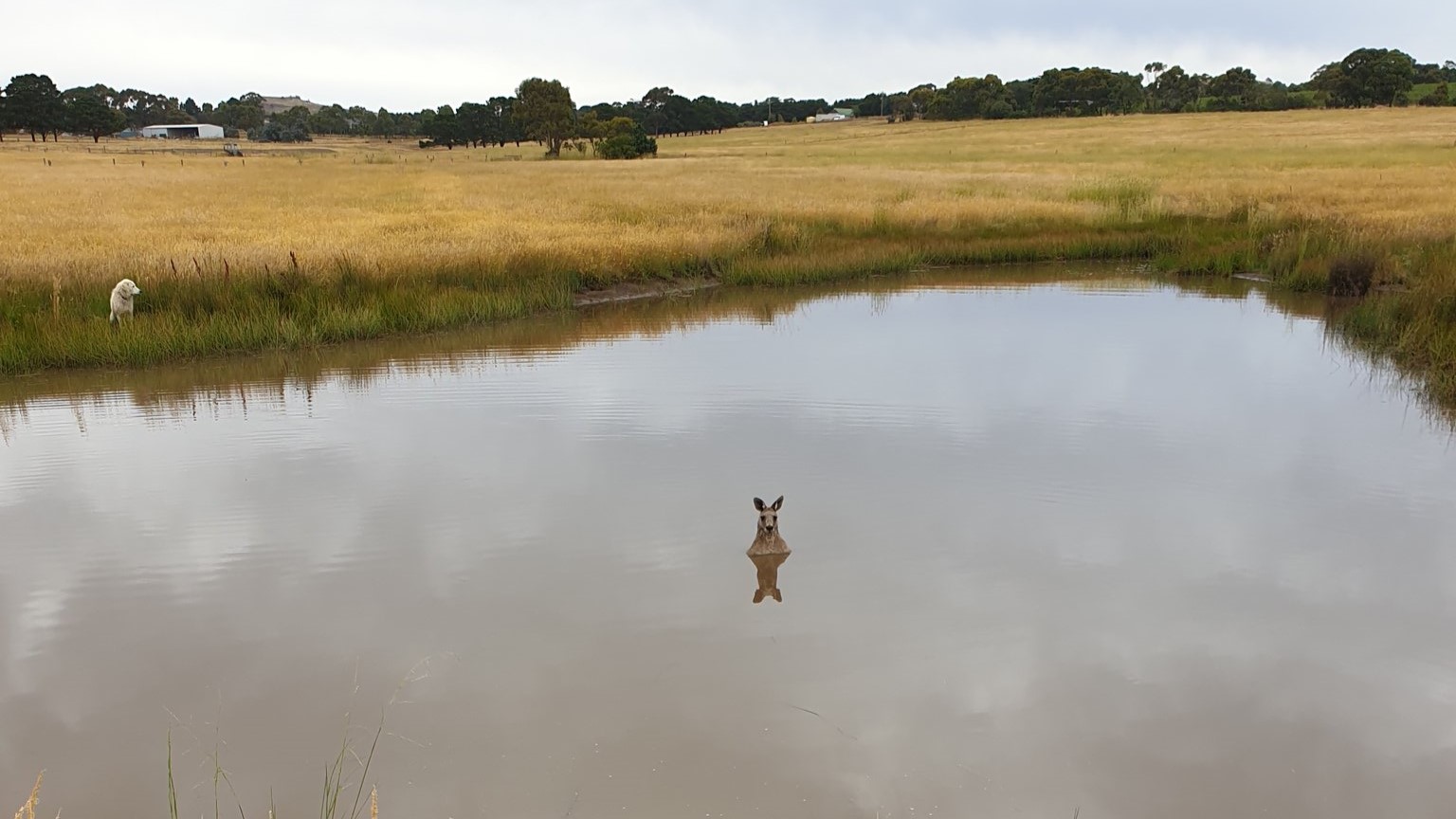Kangaroos might try to drown your dog. Here's why.
Footage of a kangaroo attempting to drown a dog in a river in Australia went viral online, but this isn't the first time a marsupial has pulled this trick.

Mick Moloney was walking on the banks of the Murray River in northwestern Victoria, Australia, when he noticed his dog Hutchy was missing. He glanced toward the water and saw a kangaroo standing waist-deep in the river with its arms submerged.
"Next thing you know, Hutchy came up gasping for air, water spilling out of his mouth and screaming his head off," Moloney told the Australian broadcaster 7News.
Moloney waded through the water to retrieve his dog, which the kangaroo was gripping from behind, and took a swing at the offender, a video that has since gone viral showed. The kangaroo retaliated with a punch, but both Moloney and Hutchy eventually made it safely back to the riverbank.
The bizarre run-in, which occurred on Oct. 12, is the latest recorded duel between a kangaroo and a pet dog, where it appears the kangaroo is trying to drown the dog.
Related: Mammals with pouches are 'more evolved' than humans — sort of
In 2020, a small dog nearly met its fate after clashing with a 5 foot (1.5 meter) tall kangaroo in Brisbane River in Queensland, 7News Sydney reported. And in 2014, a kangaroo tried to drown two staffies after the dogs cornered it in a dam in New South Wales. But why do the marsupials behave in this way?
A small dog and kangaroo have gone toe to toe in a bizarre tussle a Brisbane river. Witnesses filmed the clash that started on land before the pair plunged into the water. https://t.co/JkJj1kxZpm #7NEWS pic.twitter.com/4VAYTIqNAfJanuary 14, 2020
Kangaroos perceive dogs as a threat because dogs closely resemble dingoes — one of their deadliest predators, said Euan Ritchie, a professor of wildlife ecology and conservation at Deakin University in Australia.
Sign up for the Live Science daily newsletter now
Get the world’s most fascinating discoveries delivered straight to your inbox.
"This behavior is one way that kangaroos have learnt to survive attacks by dingoes, a native top predator they've coexisted with for many thousands of years," Ritchie told Live Science in an email.
Dingoes (Canis dingo) are Australia's largest land predators and genetically sit somewhere between a wolf and a modern domestic dog. Humans likely brought the ancestors of modern dingoes to the mainland between 5,000 and 8,500 years ago, and the canines gradually settled for a diet of marsupials and reptiles. Modern dogs weren't introduced to Australia until 1788, when the first ships carrying British and Irish convicts arrived on the continent.

Dingoes hunt kangaroos in large packs, relaying each other to chase their prey until exhaustion. To kill them, dingoes either bite at their hind legs to slow them down before going for the throat, or approach kangaroos from the side to bite at the neck directly.
Kangaroos seek refuge from dingoes by hopping into the nearest body of water — an escape strategy that "works well for domestic and farm dogs too," Ritchie said. Should a dingo or dog chase after them, the kangaroo might attempt to drown it.
"It's an instinctive behavior that has evolved as a defense against predators," said Graeme Coulson, an honorary principal fellow at the University of Melbourne in Australia specializing in kangaroo behavior and ecology. "Males are strong enough to stand up and handle a four-legged dog-paddling adversary," he told Live Science in an email.
Male eastern gray kangaroos (Macropus giganteus) — one of Australia's four species of kangaroos, to which the kangaroo that tried to drown Hutchy belonged — can weigh up to 150 pounds (70 kilograms), Ritchie said. "The males have long, very powerful, muscular arms, and long, sharp claws, and they'll use these to hold a dog and push it under the water in an attempt to drown it," he said.
The largest living species of kangaroo is the red kangaroo (Osphranter rufus), with the males weighing up to 202 pounds (92 kg).
Dog owners should also beware of kangaroos, as they can sometimes attack people, Ritchie said. "A powerful kick or scratch can do serious harm," he said. "Dog owners should ensure kangaroos aren't being harassed or harmed, which also ensures their dogs are kept safe too."

Sascha is a U.K.-based staff writer at Live Science. She holds a bachelor’s degree in biology from the University of Southampton in England and a master’s degree in science communication from Imperial College London. Her work has appeared in The Guardian and the health website Zoe. Besides writing, she enjoys playing tennis, bread-making and browsing second-hand shops for hidden gems.









